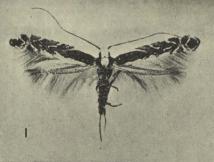Wattle miner facts for kids
Quick facts for kids Wattle miner |
|
|---|---|
 |
|
| Scientific classification | |
| Synonyms | |
|
The wattle miner (scientific name: Acrocercops alysidota) is a tiny moth that belongs to a family called Gracillariidae. These moths are known for their interesting way of eating leaves. You can find them in different parts of Australia, including New South Wales, Queensland, Victoria, Southern Australia, and Western Australia. They also live in New Zealand.
Contents
About the Wattle Miner Moth
What the Wattle Miner Looks Like
This small moth has a wingspan of about 8 mm, which is less than half an inch. Imagine a small button or a pea; that's roughly how wide its wings are when spread out!
The adult moths have a special fringe of hairs along the back edge of each wing. Their front wings have cool light and dark patterns that look like "chevrons" (V-shapes). The back wings are a pretty golden-brown color.
Where Wattle Miners Live
Wattle miners are found in many places. They live across a large part of Australia, from the eastern states like New South Wales and Queensland, all the way to Western Australia. They also make their home in New Zealand.
How Wattle Miners Grow and Eat
The young wattle miner moths are called larvae, which are like caterpillars. These larvae are very picky eaters! They mostly feed on the leaves of certain types of wattle trees, also known as Acacia trees. Some of their favorite trees include Acacia longifolia, Acacia melanoxylon, Acacia pycnantha, and Acacia saligna.
The Leaf Mining Process
The larvae are called "leaf miners" because they live inside the leaves of their host plants. They dig tunnels, or "mines," right between the top and bottom layers of the leaf.
The mine starts as a long, thin tunnel. It usually twists and turns, going up and down the leaf. At first, the tunnel looks white. You can see a thin brown or black line in the middle; this is "frass" (which is a fancy word for insect droppings).
As the larva grows, the mine changes. It becomes a lighter green than the rest of the leaf. This part of the tunnel is filled with tiny bits of frass. When the mine gets old, the part of the leaf covering it dies and turns brown. If too many larvae mine a leaf, it can dry up and fall off the tree. Sometimes, the end of the tunnel gets wider, forming a small, irregular blotch.


